Unlocking the secret to pristine kitchenware isn’t just about aesthetics; it’s a culinary art form that ensures your pots and pans gleam like new with each use.
From tackling stubborn stains to preserving the luster of stainless steel, every scrub and polish adds to the story of your culinary adventures.
Dive into our guide on how to clean pots and pans to discover expert tips, timeless techniques, and the transformative power of a sparkling kitchen arsenal that’s ready to shine with every meal you create.
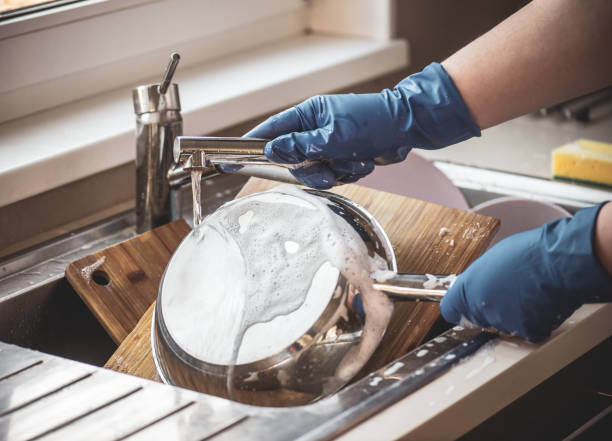
How To Clean Pots And Pans To Look Like New
Sure, here are eight effective ways to make your pots and pans look like new:
1. Good Washing
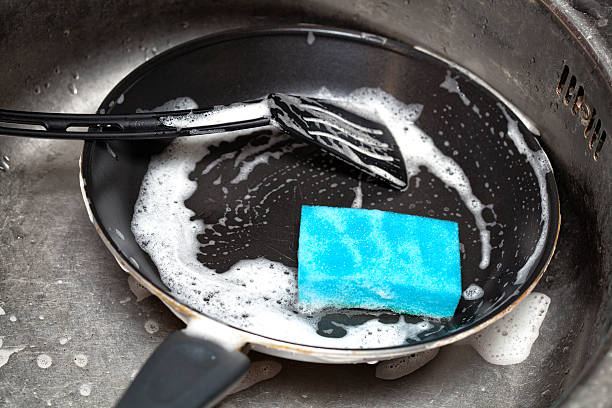
Good washing is essential for maintaining the appearance and functionality of your pots and pans. After each use, it’s important to wash them thoroughly with warm, soapy water and a non-abrasive sponge or cloth.
This helps remove any food residue or stains, preventing them from becoming baked-on and difficult to clean later. Pay attention to all areas of the pan, including handles and edges, to ensure a thorough clean.
Avoid using harsh scrubbers or abrasive cleaners, as they can scratch the surface and diminish the pan’s lifespan.
By practicing good washing habits, you not only keep your pots and pans looking pristine but also ensure they remain in top condition for long-lasting use in your kitchen.
2. Ketchup
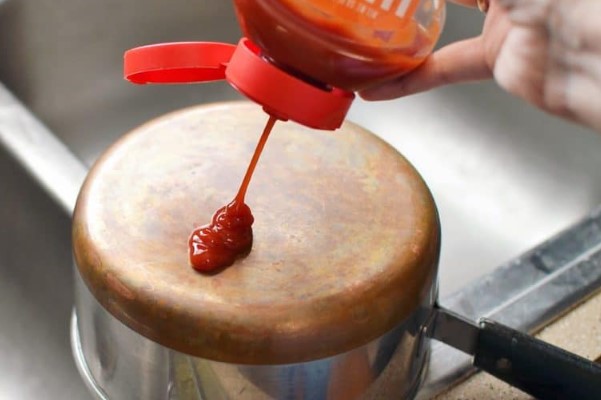
Ketchup can be surprisingly effective in cleaning pots and pans, especially those with stubborn stains or burnt-on food. Its acidity and texture make it a versatile cleaning agent.
To use ketchup for cleaning, apply a generous amount directly to the stained or burnt areas of the pan. Let it sit for a few minutes to allow the acidity to work on the stains.
Then, use a sponge or scrubber to gently scrub the affected areas. The tomato-based sauce helps break down the residues, making them easier to remove.
Rinse the pan thoroughly with warm water after cleaning. This method is particularly useful for stainless steel and copper pans but may not be suitable for non-stick surfaces.
Always test a small area first to ensure compatibility with your pan’s material.
3. Baking Soda
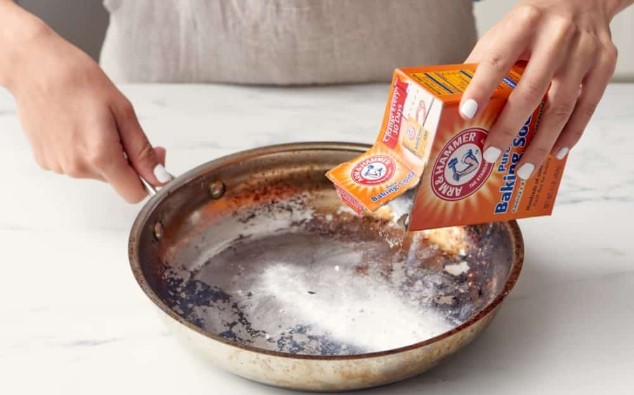
Baking soda is a versatile and powerful cleaning agent that can work wonders on pots and pans. Its mild abrasive properties make it effective in removing tough stains, burnt-on food, and grease.
To clean your pots and pans with baking soda, sprinkle a generous amount onto the surface of the pan, especially on areas with stains or residue. Add a little water to create a paste, then use a non-abrasive sponge or cloth to scrub the pan gently.
The baking soda acts as a gentle abrasive that helps lift off the stains and grime without scratching the pan’s surface. For stubborn stains or burnt spots, you can let the baking soda paste sit on the pan for a few minutes before scrubbing.
After cleaning, rinse the pan thoroughly with warm water to remove any remaining baking soda residue. This method is safe for most types of pans, including stainless steel, cast iron, and aluminum, but it’s always a good idea to test a small area first, especially for non-stick pans.
4. Vinegar And Baking Soda
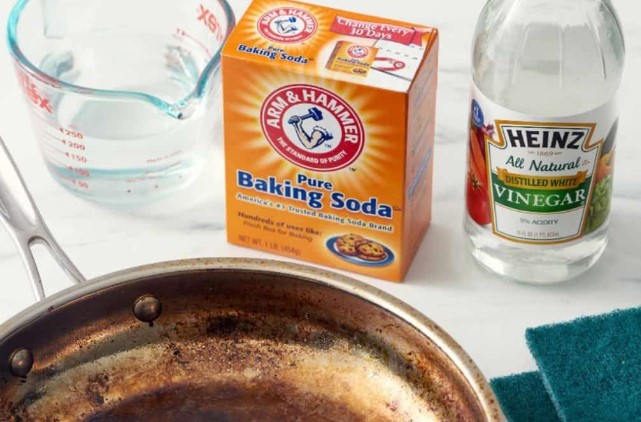
Combining vinegar and baking soda creates a powerful cleaning solution that is highly effective for restoring pots and pans to their original shine. The reaction between the acidic vinegar and the alkaline baking soda produces carbon dioxide bubbles, which help lift off stubborn stains and grime. Here’s how to use vinegar and baking soda to clean your pots and pans:
- Sprinkle Baking Soda: Start by sprinkling baking soda generously over the surface of the pan, focusing on areas with tough stains or burnt-on food residue.
- Add Vinegar: Pour vinegar over the baking soda-covered areas. You’ll notice immediate bubbling and fizzing, indicating the reaction is taking place. The bubbling action helps to loosen and lift off the stains and grime.
- Scrub Gently: Use a non-abrasive sponge or cloth to scrub the pan gently, spreading the vinegar and baking soda mixture evenly across the surface. Focus on areas that need extra cleaning attention.
- Let It Sit: After scrubbing, let the vinegar and baking soda mixture sit on the pan for a few minutes to allow it to work on stubborn stains.
- Rinse Thoroughly: Rinse the pan thoroughly with warm water to remove the vinegar and baking soda residue. You may need to repeat the process for heavily soiled pans or stubborn stains.
This method is safe for most types of pans, including stainless steel, cast iron, and aluminum. However, it’s essential to avoid using vinegar and baking soda on non-stick pans, as the abrasiveness of the baking soda can damage the non-stick coating. Always test a small, inconspicuous area first before cleaning the entire pan.
5. Borax
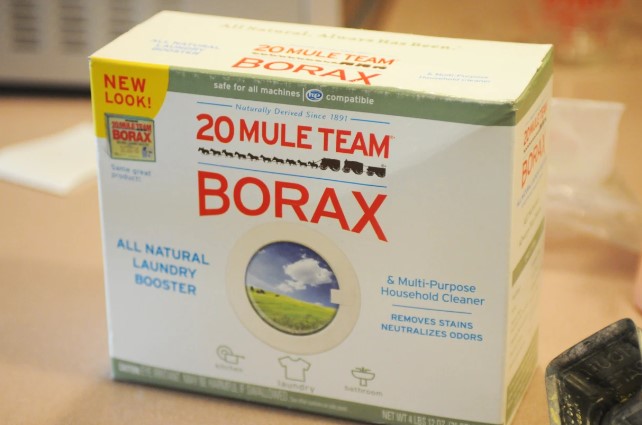
Borax, a naturally occurring mineral, is a versatile cleaner that can be used to tackle tough stains and grime on pots and pans.
Its alkaline nature makes it effective in breaking down grease and residue, leaving your cookware looking fresh and clean. To use borax for cleaning pots and pans, create a paste by mixing borax with a small amount of water.
Apply the paste to the stained or soiled areas of the pan and let it sit for a few minutes to work its magic. Then, use a sponge or scrubber to gently scrub the pan, focusing on stubborn spots.
Rinse the pan thoroughly with warm water after cleaning. Borax is safe to use on most types of cookware, including stainless steel and cast iron.
However, it’s always a good idea to test a small area first, especially for delicate surfaces or non-stick pans, to ensure compatibility and avoid any potential damage.
6. Aluminum Foil
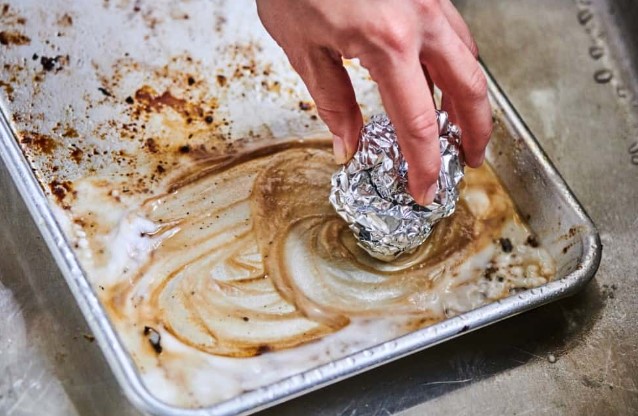
Aluminum foil can be a handy tool for cleaning pots and pans, especially those with tough stains or burnt-on residue. To use aluminum foil for cleaning, follow these steps:
- Create a Ball: Take a sheet of aluminum foil and crumple it into a ball. Make sure the ball is compact and has a somewhat smooth surface.
- Add Soap or Water: Optionally, you can dampen the aluminum foil ball with a little water or dish soap to enhance its cleaning power.
- Scrub the Pan: Use the aluminum foil ball to scrub the surface of the pan, focusing on areas with stubborn stains or burnt-on food. The foil’s abrasive texture helps to lift off the residue without scratching the pan’s surface.
- Rinse Thoroughly: After scrubbing, rinse the pan thoroughly with warm water to remove any loosened residue and aluminum foil particles.
This method is particularly useful for cleaning stainless steel and cast iron pans but may not be suitable for non-stick surfaces or delicate cookware. Always test a small area first to ensure compatibility and avoid scratching or damaging the pan.
7. Bleach

Bleach is a potent cleaning agent that can effectively remove tough stains and disinfect pots and pans. However, it’s essential to use bleach with caution and follow safety guidelines.
To clean pots and pans with bleach, dilute a small amount of bleach with water according to the manufacturer’s instructions. Wear gloves and work in a well-ventilated area to avoid inhaling fumes or getting bleach on your skin.
Submerge the stained or soiled pans in the diluted bleach solution and let them soak for a few minutes to allow the bleach to work on the stains. Use a sponge or scrubber to gently scrub the pan, focusing on stubborn spots.
Rinse the pans thoroughly with water after cleaning to remove any residual bleach. Keep in mind that bleach is not suitable for all types of pans, especially those with non-stick coatings or aluminum surfaces, as it can cause discoloration or damage.
Always test a small, inconspicuous area first and use bleach sparingly to avoid potential harm to your cookware.
8. Store Products
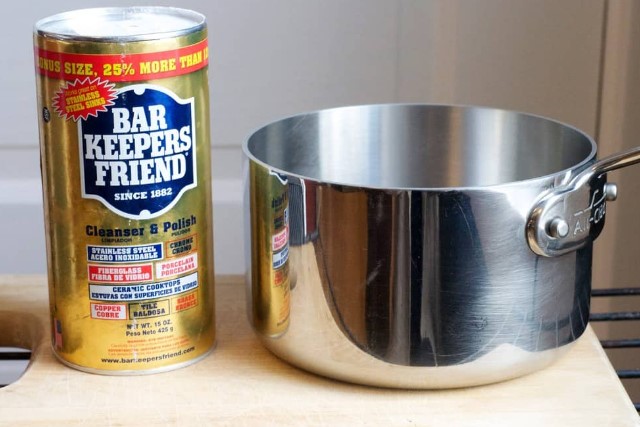
When it comes to storing pots and pans, using the right products can help maintain their condition and extend their lifespan. Here are some useful store products for organizing and protecting your cookware:
- Pot and Pan Organizers: Invest in pot and pan organizers or racks designed to keep your cookware neatly arranged and easily accessible. These organizers come in various designs, such as vertical racks, drawer organizers, and wall-mounted systems, allowing you to choose the best option for your kitchen space.
- Lid Holders: Use lid holders or racks to store pot and pan lids efficiently. These holders keep lids upright and organized, preventing them from cluttering your cabinets and making it easier to find the right lid when needed.
- Non-Slip Shelf Liners: Place non-slip shelf liners inside cabinets and drawers to prevent pots and pans from sliding around and getting scratched. These liners also help protect the cabinet surface from scratches and damage caused by cookware.
- Dividers and Inserts: Consider using dividers and inserts to create designated spaces for different types of pots, pans, and cookware accessories. This helps maximize storage space and keeps everything organized and tidy.
- Pot Protectors: Use pot protectors or felt pads to place between stacked pots and pans. These protectors prevent scratches and dings, particularly for non-stick and delicate cookware surfaces.
- Hanging Hooks: Install hooks or racks on walls or cabinet doors to hang pots, pans, and cooking utensils. This not only saves space but also makes it convenient to access frequently used items while keeping them visible and organized.
- Silicone Coasters: Place silicone coasters or trivets between stacked cookware to prevent scratches and damage. Silicone is heat-resistant and provides a protective barrier between pots and pans.
By using these store products, you can keep your pots and pans organized, protected, and in good condition, making cooking and kitchen maintenance more efficient and enjoyable.
Before You Leave
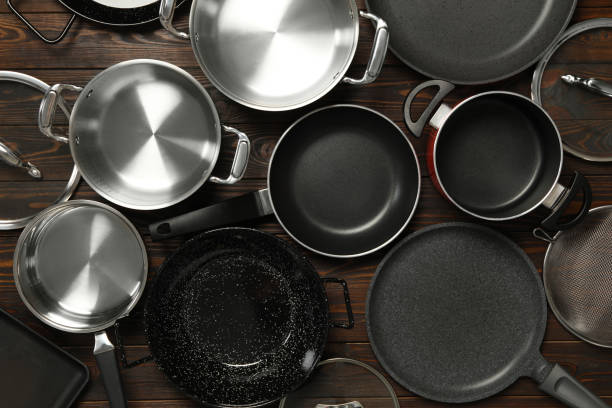
Here’s a checklist to consider before leaving your kitchen:
Check The Material Of Your Pots And Pans
Before using or cleaning your pots and pans, it’s essential to check their material to ensure you’re using the right cleaning methods and utensils.
Different materials, such as stainless steel, cast iron, non-stick coatings, and copper, require specific care to maintain their quality and longevity.
For example, stainless steel pans can withstand more abrasive cleaning techniques, while non-stick pans require gentle cleaning with non-abrasive tools to avoid damaging the coating.
Cast iron pans benefit from seasoning and should be dried thoroughly after washing to prevent rust. Copper pans may need special cleaners to maintain their shine.
By understanding the material of your cookware, you can ensure they stay in excellent condition and continue to provide reliable performance in your kitchen.
Avoid Repetition
Before using or cleaning your pots and pans, it’s crucial to identify their material to apply the appropriate care techniques. Each material, such as stainless steel, cast iron, non-stick coatings, and copper, has specific maintenance needs.
For instance, stainless steel pans are durable and can withstand more rigorous cleaning methods, while non-stick pans require gentle handling to avoid scratching the coating.
Cast iron pans benefit from regular seasoning and thorough drying after washing to prevent rust. Copper pans may need specialized cleaners to preserve their luster.
Understanding the material of your cookware helps ensure they remain in top condition, providing optimal performance and longevity in your kitchen.
Let The Pan Cool Down
Allowing your pan to cool down before cleaning is essential to prevent damage and ensure safe handling. Hot pans can be hazardous and may cause burns if touched directly.
Allowing the pan to cool also helps prevent warping, especially for materials like non-stick coatings and cast iron. Moreover, cooling down before cleaning allows any stuck-on food or residue to solidify slightly, making it easier to remove without damaging the pan’s surface.
Always exercise caution and patience by letting your pan cool down sufficiently before proceeding with cleaning or handling.
Consider Replacing Your Pots And Pans
Considering replacing your pots and pans is important for maintaining optimal cooking performance and safety in the kitchen. Over time, cookware can show signs of wear and tear, such as scratches, dents, or a worn-out non-stick coating.
These issues not only affect the appearance of your cookware but can also impact its functionality. For example, scratched non-stick pans may release harmful chemicals or lose their non-stick properties, leading to food sticking and uneven cooking.
Similarly, dented or warped pans may not heat evenly, affecting the quality of your dishes. When assessing whether to replace your pots and pans, also consider your cooking habits and needs.
Investing in high-quality cookware that suits your cooking style can enhance your culinary experience and ensure safer and more efficient cooking outcomes.
Buying New Pots And Pans
When buying new pots and pans, several factors should guide your decision to ensure you get cookware that meets your cooking needs and preferences. Consider the following tips:
- Material: Choose cookware materials based on your cooking habits and preferences. Stainless steel is durable and versatile, suitable for a wide range of cooking techniques. Cast iron provides excellent heat retention and is ideal for searing and frying. Non-stick coatings are convenient for low-fat cooking and easy cleaning. Copper offers superior heat conductivity but requires more maintenance.
- Size and Type: Select pots and pans in sizes that match your cooking requirements. Consider the types of dishes you frequently prepare and choose cookware accordingly, such as saucepans, frying pans, sauté pans, stockpots, and specialty pans like woks or Dutch ovens.
- Compatibility: Ensure your new cookware is compatible with your stovetop, whether gas, electric, induction, or glass-ceramic. Check the manufacturer’s specifications to confirm compatibility.
- Handles and Lids: Opt for pots and pans with ergonomic handles for comfortable grip and heat resistance. Lids should fit securely to retain moisture and flavors during cooking.
- Quality and Durability: Invest in high-quality cookware from reputable brands known for durability and performance. Quality cookware may cost more upfront but can last longer and provide better cooking results over time.
- Maintenance: Consider the maintenance requirements of the cookware you choose. Some materials, like stainless steel and cast iron, require seasoning or specific cleaning methods for optimal performance and longevity.
- Budget: Set a budget based on your cooking needs and prioritize essential pieces of cookware. You can always expand your collection gradually as needed.
By considering these factors and researching different options, you can make informed decisions when buying new pots and pans that enhance your cooking experience and last for years to come.
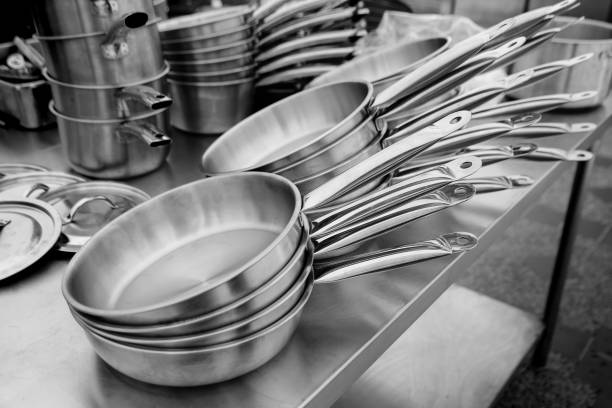
Frequently Asked Questions (FAQs) – Cleaning Pots And Pans To Look Like New
Q: How can I make my pots and pans sparkle like they’re brand new?
A: With a gentle yet effective cleaning routine, you can restore your cookware’s shine and keep it looking flawless.
Q: What’s the secret to removing stubborn stains from pots and pans?
A: Using natural solutions like baking soda and vinegar can work wonders in lifting tough stains without damaging the surface.
Q: Is there a way to prevent my pots and pans from looking dull over time?
A: Yes, regular maintenance such as seasoning and proper storage can help maintain the luster of your cookware for years to come.
Q: Can I use abrasive cleaners on my pots and pans without causing damage?
A: It’s best to avoid harsh abrasives and opt for gentle cleaning methods to preserve the quality and appearance of your cookware.
Q: How often should I deep clean my pots and pans to keep them looking new?
A: Depending on usage, a thorough cleaning every few weeks can work wonders in maintaining that fresh, like-new look.
Q: Are there any special tips for cleaning specific types of cookware, like stainless steel or non-stick pans?
A: Absolutely! Tailoring your cleaning approach to the material of your cookware can ensure optimal results without any damage.
Q: What’s the best way to dry my pots and pans after cleaning to avoid water spots?
A: Using a soft, clean cloth to dry your cookware thoroughly can prevent water spots and maintain its pristine appearance.
Q: Can I use dishwasher pods for cleaning my pots and pans?
A: While dishwasher pods are convenient, handwashing with mild soap is often recommended for preserving the beauty of your cookware.
Q: Are there any eco-friendly cleaning solutions that work well for pots and pans?
A: Yes, many eco-friendly cleaners are gentle yet effective in restoring the shine of your cookware while being kind to the environment.
Q: How can I prevent food residues from sticking to my pots and pans during cooking?
A: Using the right amount of oil or cooking spray and avoiding overheating can help prevent food from sticking and make cleaning easier.
Conclusion
To conclude, maintaining the pristine appearance of your pots and pans is not only about aesthetics but also about extending their lifespan and ensuring safe and healthy cooking.
By following the proper cleaning techniques tailored to each type of cookware, you can keep them looking like new for years to come.
Remember to avoid harsh abrasives, use appropriate cleaning agents, and follow manufacturer’s instructions for the best results. With a little care and attention, your pots and pans will continue to shine, enhancing your culinary experiences every time you cook.
Other Articles You May Also Like:
- How To Clean Calphalon Pans (7 Essential Steps)
- How To Clean A Non Stick Pan (5 Revealing Steps)
- How To Clean Stainless Steel Pans (13 Cool Ways)
- How To Clean Baking Sheets (6 Easy Ways)
- How To Clean Stove Drip Pans (8 Easy Ways)
- How To Clean Muffin Pan (4 Easy Steps)
- How To Clean Ceramic Pan (10 Easy Ways)